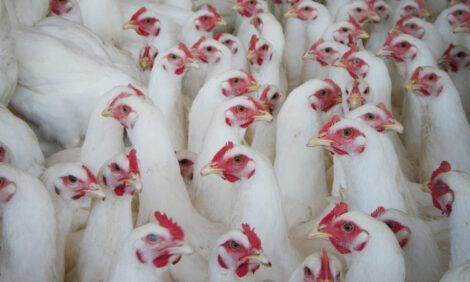



Japan - Poultry and Products Annual 2009
Broiler meat consumption is expected to be lower this year than in 2009 and imports from Brazil are likely to be impacted particularly, according to Kakuyu Obara in the latest GAIN report from the USDA Foreign Agricultural Service.Executive Summary
Broiler consumption is projected to remain strong in 2010, however competition with other inexpensive food items will likely decrease total consumption from the previous year. Total broiler imports in 2010 are expected to decrease further, by three per cent from last year to 680,000 MT. Reduced imports should help to bring down the high level of stocks carried over from the previous year. Brazil, the single largest supplier of bulk broiler meat cuts (bone-less) to Japan, will be impacted the most. Thailand and China, two dominant suppliers of cooked broiler meat products, are expected to maintain a strong presence in the market in 2010, supported by relatively solid demand for prepared foods.
Market Overview
With the impact of the economic recession still prevailing in Japan, it is difficult to predict next year's outlook for Japan broiler market at the present point in time. Despite a slightly positive economic growth forecast for 2009, the high jobless rate and negative income growth is still hampering a real recovery. In the early part of 2010, Post expects that Japan will use surplus broiler stocks that carried over to beginning stocks from the previous year. The situation will not only force domestic producers to adjust their outputs, but most likely lead to reduced broiler imports.
Quantities listed in the text are made on the basis of product weight and no conversion rates are used (unless specified otherwise):
- Domestic broiler meat – dressed whole, bone-in
- Imported broiler meat – customs clearance basis (boneless and bone-in combined but the majority is boneless)
- Imported prepared broiler products – customs clearance basis
- Stocks – Product Weight (mostly boneless) – include small amount of spent hen stocks, no broiler specific stock data are available.
Outline of Japan's Broiler Market Structure
Broiler meat comprises over 90 per cent of the Japanese poultry meat market. In general, Japanese consumers prefer leg meat (bone-less) over breast meat. Nearly half of total imports are 'prepared (or cooked) products of broiler meat', mainly supplied by Thailand and China. The Government of Japan (GOJ) has maintained a suspension on imports of broiler meat from these two countries due to persisting outbreaks of HPAI (highly pathogenic avian influenza).
Domestic broiler meat maintains the majority share of sales in the retail sector. Japan's food service sector utilises large quantities of imported raw bulk cuts, the bulk of which are from Brazil. Japan was once a major market for US bone-in leg cuts, including those to be processed into prepared products after entry into Japan. However, market share has decreased over the past two decades due to competition from other suppliers.
2010 Broiler Market Outlook
Previous year surplus to be reduced in 2010
Tangible improvements in the real economy are expected to take some time, particularly with the current high rates of joblessness and negative income growth that has persisted since 2009. The situation favours lower priced food items, and broiler consumption is projected to remain at 1.96 million MT – the same level as the previous year. However, surplus carry-over stocks from the previous year, coupled with increased competition from other low-priced meats (pork and beef) and processed meat products (ground meat products, sausages, etc.), will likely force the market to make some adjustments in supply in early 2010.
As a result, total imports in 2010 are projected to decrease from the previous year by three per cent to 680,000 MT. Bulk broiler meat cuts imports are expected to decline by five per cent to 360,000 MT, while prepared and processed products remain unchanged at 320,000 MT. Japanese importers are expected to import less than the previous year through the early part of 2010, though the final import figures will depend on how quickly unsold imported stocks are exhausted, and the degree to which Japan's food service market improves. Brazil, the single largest supplier of bulk bone-less broiler cuts, will likely be affected the most by the decline in imports. Thailand and China are expected to maintain a strong presence in Japan's prepared foods market segment, however, it remains to be scene if China can regain market share that was recently lost to Thailand.
Domestic producers are also expected to start responding to weak market prices of the previous year by adjusting their outputs in 2010. Thus, total domestic broiler production is projected to decrease slightly to 1.255 million MT.
2009 Broiler Market Situation Update and Outlook
A slump in food-service market to result in surplus in 2009
Japanese consumers are expected to continue to favour lower priced broilers, as was the case in 2009, with total consumption projected to increase by two per cent over 2008. However, due to a deepening economic recession and stagnant population growth, Japan's broiler market has been affected by a slow-down in consumption since late 2008. The food-service segment, where the majority of bulk imported broiler cuts are distributed, has been significantly impacted. The fast food segment has been the only exception in the entire food service sector to maintain positive sales growth until the first half of 2009. However, chicken products have started to face competition with other inexpensive substitutes such as ground meat products and sausages in 2009. Consequently, large poultry stocks from 2008 were carried over to 2009 (beginning stock was estimated up 50 per cent at 176,000 MT) and June monthly ending stock in 2009 was still 34 per cent higher than the same month last year.
As a result of the high levels of rollovers in stocks, Japan's total broiler imports are expected to decrease by five per cent to 700,000 MT. Bulk broiler meat cuts were slashed by 11 per cent to 380,000 MT, while prepared and processed products were up by three per cent to 320,000 MT. Even then, stock levels are not expected to decline significantly before the end of the year, and are estimated to decrease only slightly from the beginning of the year to 171,000 MT.
Imports of bulk broiler meat cuts to decrease in 2009
Trade sources report that many Japanese importers are facing heavy financial burdens due to erroneous price speculations in 2008 in advance of a massive wave of imports of expensive Brazilian boneless leg cuts. With the present import price lower than the previous year, coupled the with strong yen, Post is not certain to what extent Japanese importers are planning to cut back their second half purchases from Brazil. The average import price of bulk cuts of broiler meat in 2008 was 57 per cent higher than 2007 at US$3.07. However, during the first half of 2009 the average CIF price has come down to US$2.78.
Opportunities for US broiler meat to expand further in the Japanese market are limited by a shortage in the supply of boneless leg cuts. Thus, imports of US broiler meat (mostly bone-in legs) to Japan in 2009 are projected to be lower than the previous year at 21,000 MT.
Meanwhile, solid household consumption for domestic broiler meat (retail sector), combined with prices lower than the previous year, have continued through the first half of 2009. Therefore, domestic boiler outputs through 2009 are expected to remain at relatively high levels, with the annual total projected to reach around 1.26 million MT. Various subsidy programmes implemented in JFY 2008 and 2009, including the feed price subsidy scheme, will also support the situation noted above and likely delay producers' response to weaker market prices. However, industry sources predict that sales competitions from domestic broiler meat with increased supplies of low-priced pork and beef cuts will intensify in the second half of 2009.
Imports of cooked products forecast to remain solid in 2009
Chinese exports of cooked broiler products to Japan are not expected to recover fully in 2009 from the set-back suffered following a series of food safety-related incidents and scandals in Japan. The scandals were not necessarily specific to broiler products but rather other products such as dumplings and infant milk.
However, Thai products have successfully filled the gap created in Japan's ready-to-eat market with the imports from China down six per cent to 60,529 MT. Imports from Thailand are up 12 per cent for the same product at 85,107 MT in the first half of 2009. This market segment is particularly price sensitive and is expected to compete with ample supplies of low priced domestic broiler breast meat, which are further processed into ready to eat food items.
Further Reading
| - | You can view the full report by clicking here. |
January 2010











